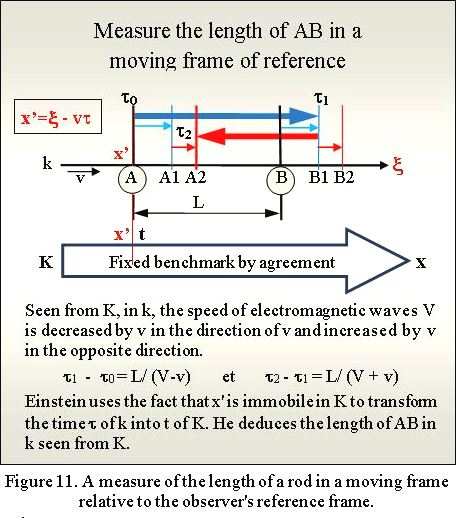Bonjour. visiteurs jour : 176
Au président
Beauté santé
Infos loisirs
Ensemble
Jean
Informatique
Einstein
Santé corona
français
Welcome -
Einstein's relativity -
The ether -
Galileo's relativity -
Waves -
References
Translation in progress, coming soon
Relativity
Shadow areas to illuminate.
It seems that a lot of things have been forgotten

« Founding article from 1905 »
The articles that describe special relativity always talk about the experiment of Michelson and Morley which failed and the way in which Hendrik Lorentz brought an explanation to the phenomenon with his transformations which were finalized in a masterful way on the mathematical level by Henri Poincaré.
§2 ON THE RELATIVITY OF LENGTHS AND TIMES
We forget on this occasion the work
many precursors including Woldemar Voigt the first to find the contraction :
 or even
Oliver Heavisidewho simplified Maxwell's equations and his discovery that the electric field of a spherical electron at rest flattens in the direction of motion to form an ellipsoid whose contraction in the direction of motion is root (1 - v²/c²) or the contraction found by Woldemar Voigt which will be taken up by Lorentz and rediscovered by Albert Einstein.
or even
Oliver Heavisidewho simplified Maxwell's equations and his discovery that the electric field of a spherical electron at rest flattens in the direction of motion to form an ellipsoid whose contraction in the direction of motion is root (1 - v²/c²) or the contraction found by Woldemar Voigt which will be taken up by Lorentz and rediscovered by Albert Einstein.
Albert Einstein does not use the Michelson and Morley experiment. He quoted it as corroborating his two basic postulates which are: "the relativity of motion extended to electromagnetic phenomena" and the "universal constant of the speed of light".
Here is the approach of Albert Einstein to establish the transformations which in the end are the same as those of Lorentz.
Consider a rigid rod at rest in a frame K; it has a length l when measured by a ruler at rest. What is the length of the moving rod in the frame k moving at speed v with respect to K? The parts in italics were written by Albert Einstein in his articles.
a) The observer provided with the ruler to be measured moves with the rod to be measured and measures its length by superimposing the ruler on the rod, as if the observer, the ruler to be measured and the rod were at rest.
b) The observer determines at which points of the stationary system are the ends of the rod to be measured at time t, using the clocks placed in the stationary system (the clocks being synchronized as described in § 1). The distance between these two points, measured by the same measuring ruler when it was at rest, is also a length, which we call the "rod length". » 14
In this article Einstein designates the speed of light by the letter V. The letter c will be used later. It is the initial of the word celerity which indicates an exceptionally high speed.

Einstein applies the additivity of the speed v of k to the speed V of light waves of small k seen from K.
It is not the speed of light seen from K that varies but the distance to be traveled. To go from A to B the light ray must catch up with the point B which moves away at the speed v. The resulting velocity seen from K is V - v. On the return it is the opposite, point A approaches at speed v and seen from K the resulting speed is V+v.
§ 3. Coordinate transformation theory
and time of a stationary system
to another in uniform relative motion
It is in this paragraph that Albert Einstein uses the point x' which moves in k at the speed v. Therefore the point x' is seen motionless from K.
Einstein will use it to transfer the coordinates of the points x, y, z and t from k to the coordinates of K: x, y, z and t. We will not detail the calculations here.
The speed of light in k is V, the same as that in K despite the fact that k moves relative to K. Additivity of speeds would dictate that if the ether existed, a speed V of light in K should drive at a speed of light from V-v in k. Except to consider that the speed of the ether with respect to k is zero and the same with respect to K. The ether should be immobile both in K and in k. This is what led Albert Einstein in 1920 to say that we cannot speak of the speed of the ether, that these cannot be determined.
Note 14: University of Quebec at Chicoutimi On the electrodynamics of moving bodies page 13 paragraph 3